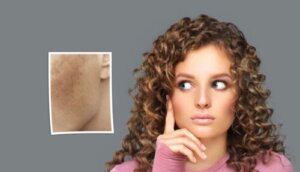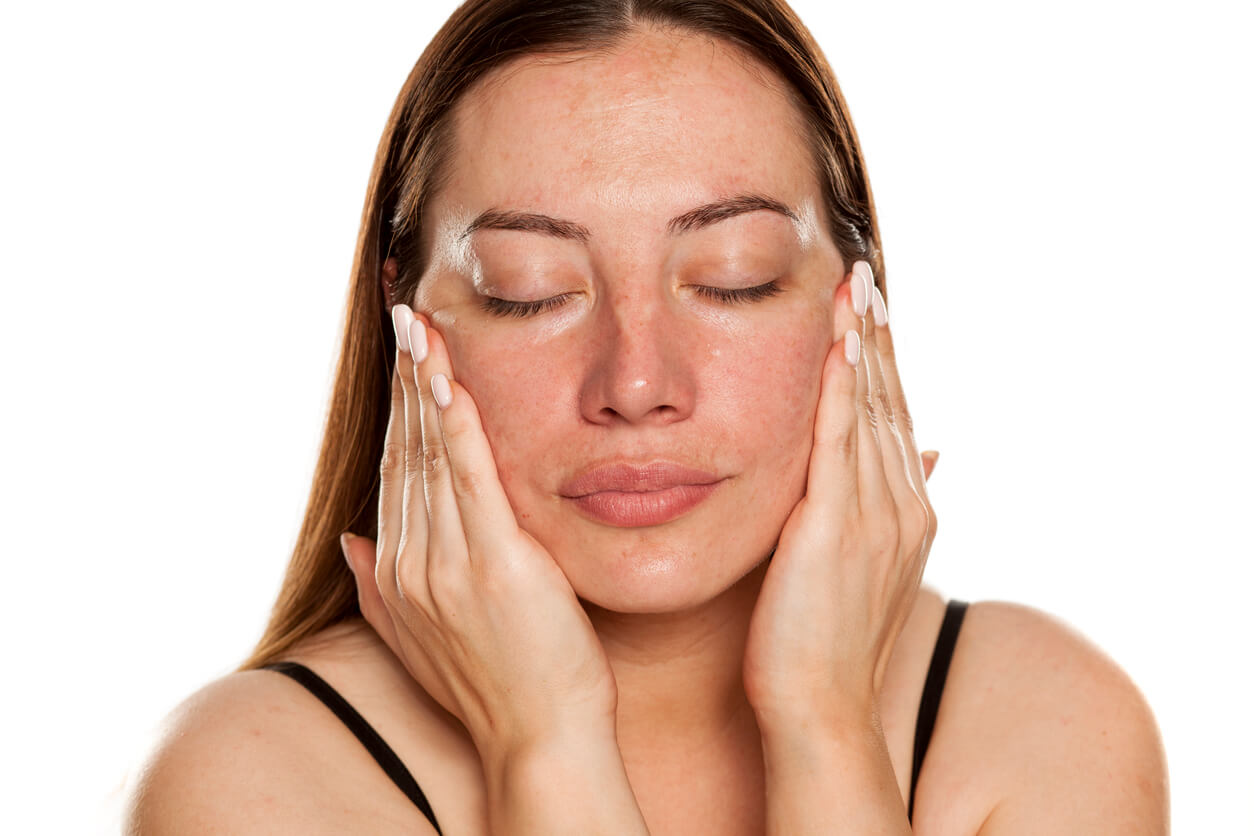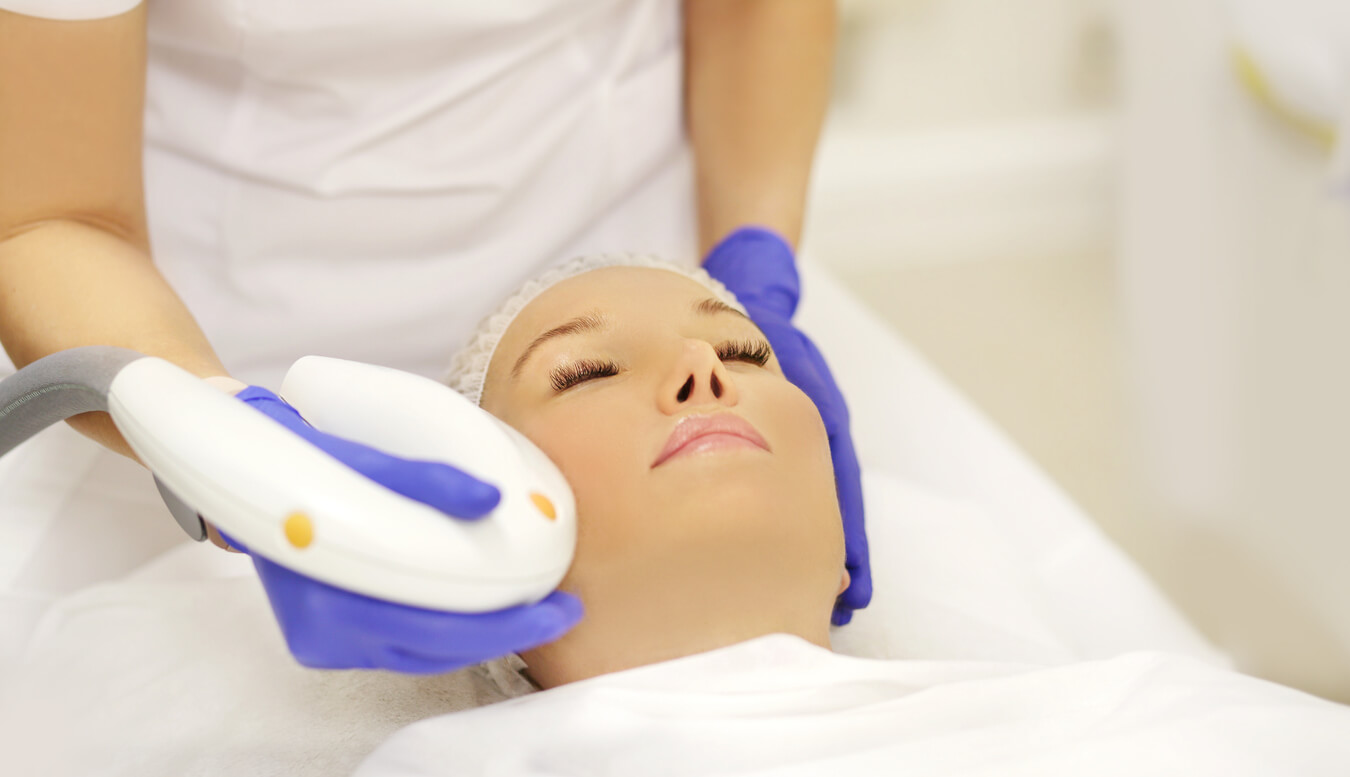Facial Spots During Pregnancy: How to Treat Them?


Written and verified by the dermatologist Maria del Carmen Hernandez
The vast majority of women develop facial spots during pregnancy. Although they’re not serious, they’re usually annoying and unsightly, so it’s a good idea to start a treatment to reduce them. But do you know what you can do about them? In the following article, we’ll tell you.
Why do facial spots during pregnancy appear?
Between 50 and 75% of women notice new, dark facial spots during pregnancy. This condition is called melasma and is caused by the high level of estrogen and progesterone in the body. Hyperpigmentation develops due to excessive melanin production, stimulated by hormonal changes during pregnancy.
The prevention of facial spots during pregnancy
Exposure to ultraviolet rays makes the spots developed during pregnancy more pronounced. Therefore, it’s important to use a broad-spectrum sunscreen with an SPF greater than 30 on the face and renew it every two hours. It’s also crucial to establish a routine of using this product every day, even when you’re not exposed to the sun or on cloudy days.
Ideally, you should stay out of the sun during the hours when the rays are strongest, between 1 am and 3 pm. In addition, the use of physical protectors, such as sunglasses or wide-brimmed hats, is a good practice to implement.

Therapeutic options for facial blemishes
Treatments for facial blemishes include oral, topical, procedural, and combined therapeutics. First-line therapy consists of topical compounds that affect the melanin synthesis pathway, a broad-spectrum photoprotectant that serves as camouflage.
Hydroquinone cream
The efficacy of treating melasma with hydroquinone alone or in combination with other agents is well-established. Hydroquinone 2% or 4% is used as monotherapy or in a combination preparation. Results begin to become evident after 5 to 7 weeks of treatment. Therefore, it should be continued for at least 3 months and even up to 1 year.
Regular medical checkups should be performed every 3 to 6 months, according to the patient’s skin type. The most common adverse effects of this treatment are burning and erythema.
Corticosteroids
Topical corticosteroids act as anti-inflammatories that decrease the turnover of the most superficial cells. Therefore, they may cause a mild spot-reducing effect on the face. These are one of the active components of triple-combination cream, along with tretinoin.
You may be interested in: 10 Homemade Exfoliating Scrubs for Skincare During Pregnancy
Triple-combination cream
Avoid the sun, use sunscreen correctly, and follow the application directions when using triple antibiotic ointments. This is the most effective first-line treatment to combat facial spots during pregnancy. The synergistic action of the three topical agents achieves a greater depigmenting effect than any of the agents alone. The combined treatment should be discontinued or tapered after 4 to 8 weeks.

Intense pulsed light and laser
The combination of intense pulsed light and QS laser provides the rapid resolution of melasma with potential long-term benefits. This makes it a good therapeutic option for treating facial spots during pregnancy.
Tranexamic acid
Tranexamic acid is the most common adjuvant therapy used. It works by decreasing melanin formation and provides sustained and rapid lightening of facial spots during pregnancy. In addition, there’s the option of oral medication. In fact, most cases treated this way improve after 2 to 6 months.
Chemical peels
Chemical peels used to treat facial blemishes are quite effective. In fact, the use of glycolic acid, salicylic acid, or trichloroacetic acid is effective in the treatment of melasma. Chemical peels produce controlled exfoliation, followed by regeneration of the dermis and epidermis. Also, this process can be expected in 3 to 5 days and may require successive sessions.
Spots on the face aren’t only clinical manifestations
The management of spots on the face can be very challenging and requires the initiation of long-term treatment with topical medications. Although they don’t cause symptoms in women, they produce discomfort and insecurity regarding aesthetics. Generally, this condition leads to opting for therapeutic options that lighten the hyperpigmented patches on the face.
The vast majority of women develop facial spots during pregnancy. Although they’re not serious, they’re usually annoying and unsightly, so it’s a good idea to start a treatment to reduce them. But do you know what you can do about them? In the following article, we’ll tell you.
Why do facial spots during pregnancy appear?
Between 50 and 75% of women notice new, dark facial spots during pregnancy. This condition is called melasma and is caused by the high level of estrogen and progesterone in the body. Hyperpigmentation develops due to excessive melanin production, stimulated by hormonal changes during pregnancy.
The prevention of facial spots during pregnancy
Exposure to ultraviolet rays makes the spots developed during pregnancy more pronounced. Therefore, it’s important to use a broad-spectrum sunscreen with an SPF greater than 30 on the face and renew it every two hours. It’s also crucial to establish a routine of using this product every day, even when you’re not exposed to the sun or on cloudy days.
Ideally, you should stay out of the sun during the hours when the rays are strongest, between 1 am and 3 pm. In addition, the use of physical protectors, such as sunglasses or wide-brimmed hats, is a good practice to implement.

Therapeutic options for facial blemishes
Treatments for facial blemishes include oral, topical, procedural, and combined therapeutics. First-line therapy consists of topical compounds that affect the melanin synthesis pathway, a broad-spectrum photoprotectant that serves as camouflage.
Hydroquinone cream
The efficacy of treating melasma with hydroquinone alone or in combination with other agents is well-established. Hydroquinone 2% or 4% is used as monotherapy or in a combination preparation. Results begin to become evident after 5 to 7 weeks of treatment. Therefore, it should be continued for at least 3 months and even up to 1 year.
Regular medical checkups should be performed every 3 to 6 months, according to the patient’s skin type. The most common adverse effects of this treatment are burning and erythema.
Corticosteroids
Topical corticosteroids act as anti-inflammatories that decrease the turnover of the most superficial cells. Therefore, they may cause a mild spot-reducing effect on the face. These are one of the active components of triple-combination cream, along with tretinoin.
You may be interested in: 10 Homemade Exfoliating Scrubs for Skincare During Pregnancy
Triple-combination cream
Avoid the sun, use sunscreen correctly, and follow the application directions when using triple antibiotic ointments. This is the most effective first-line treatment to combat facial spots during pregnancy. The synergistic action of the three topical agents achieves a greater depigmenting effect than any of the agents alone. The combined treatment should be discontinued or tapered after 4 to 8 weeks.

Intense pulsed light and laser
The combination of intense pulsed light and QS laser provides the rapid resolution of melasma with potential long-term benefits. This makes it a good therapeutic option for treating facial spots during pregnancy.
Tranexamic acid
Tranexamic acid is the most common adjuvant therapy used. It works by decreasing melanin formation and provides sustained and rapid lightening of facial spots during pregnancy. In addition, there’s the option of oral medication. In fact, most cases treated this way improve after 2 to 6 months.
Chemical peels
Chemical peels used to treat facial blemishes are quite effective. In fact, the use of glycolic acid, salicylic acid, or trichloroacetic acid is effective in the treatment of melasma. Chemical peels produce controlled exfoliation, followed by regeneration of the dermis and epidermis. Also, this process can be expected in 3 to 5 days and may require successive sessions.
Spots on the face aren’t only clinical manifestations
The management of spots on the face can be very challenging and requires the initiation of long-term treatment with topical medications. Although they don’t cause symptoms in women, they produce discomfort and insecurity regarding aesthetics. Generally, this condition leads to opting for therapeutic options that lighten the hyperpigmented patches on the face.
All cited sources were thoroughly reviewed by our team to ensure their quality, reliability, currency, and validity. The bibliography of this article was considered reliable and of academic or scientific accuracy.
- Moin A, Jabery Z, Fallah N. Prevalence and awareness of melasma during pregnancy. Int J Dermatol. 2006 Mar;45(3):285-8. doi: 10.1111/j.1365-4632.2004.02470.x. PMID: 16533230.
- Draelos ZD. Skin lightening preparations and the hydroquinone controversy. Dermatol Ther. 2007 Sep-Oct;20(5):308-13. doi: 10.1111/j.1529-8019.2007.00144.x. PMID: 18045355.
- Rendon MI, Berson DS, Cohen JL, Roberts WE, Starker I, Wang B. Evidence and considerations in the application of chemical peels in skin disorders and aesthetic resurfacing. J Clin Aesthet Dermatol. 2010 Jul;3(7):32-43. PMID: 20725555; PMCID: PMC2921757.
- Rendon M, Berneburg M, Arellano I, Picardo M. Treatment of melasma. J Am Acad Dermatol. 2006 May;54(5 Suppl 2):S272-81. doi: 10.1016/j.jaad.2005.12.039. PMID: 16631968.
This text is provided for informational purposes only and does not replace consultation with a professional. If in doubt, consult your specialist.








